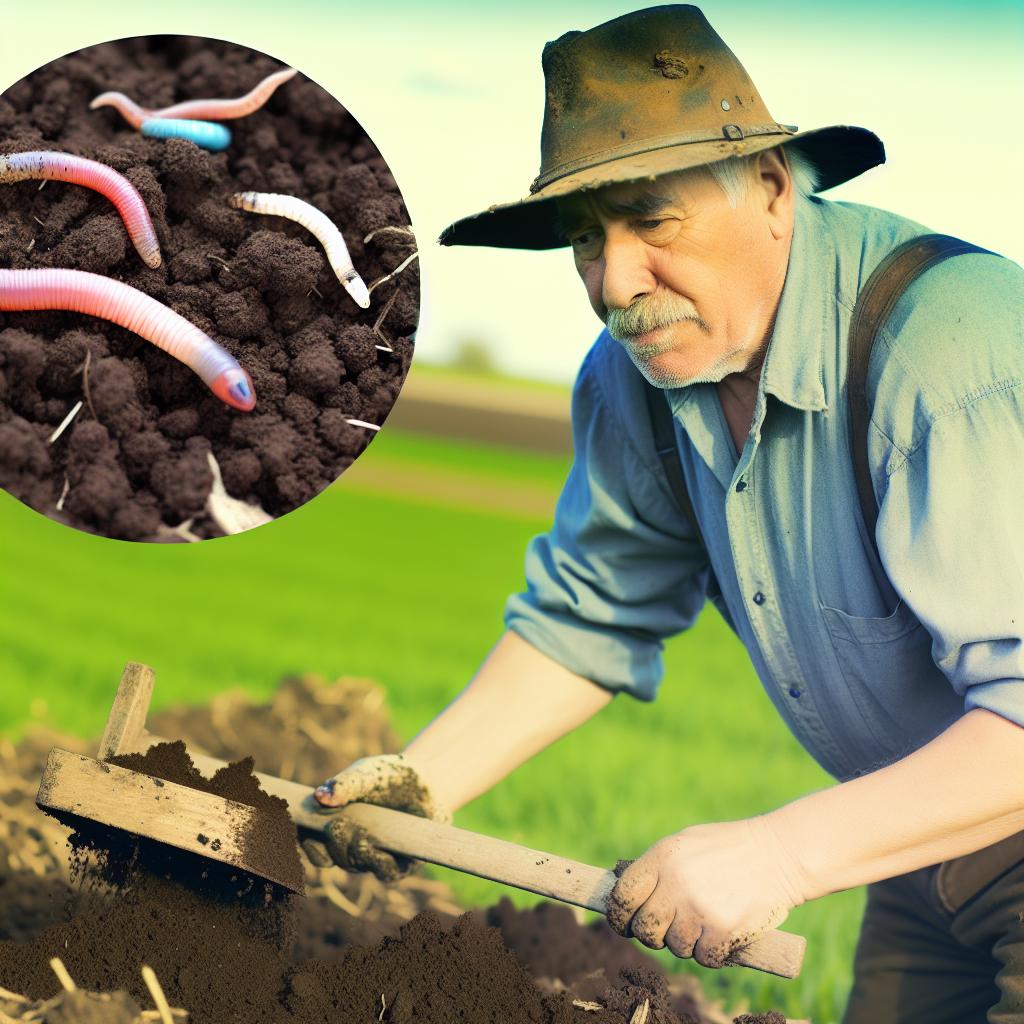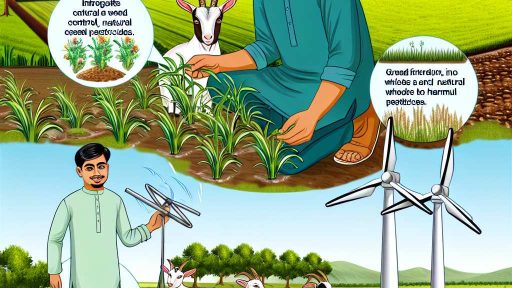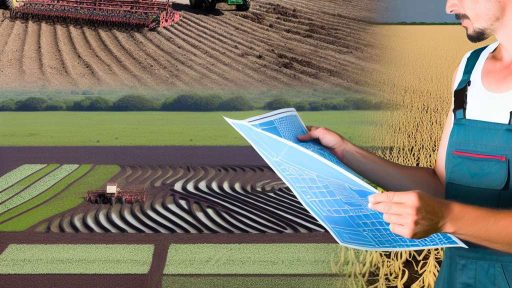Introduction to Soil Health and Its Importance in Agriculture
Soil health plays a critical role in sustainable agriculture.
Healthy soil supports plant growth and improves crop yields.
Moreover, it enhances water retention and reduces erosion.
Consequently, farmers benefit from lower input costs and better harvests.
Therefore, focusing on soil health increases overall agricultural productivity.
Understanding Soil Health
Soil health refers to the condition of soil in sustaining plant and animal productivity.
It encompasses biological, physical, and chemical properties.
Healthy soils contain a diverse community of organisms.
These organisms play vital roles in nutrient cycling and organic matter decomposition.
Consequently, they contribute significantly to soil fertility.
Benefits of Healthy Soil
Healthy soil promotes beneficial interactions within ecosystems.
It enhances water filtration and reduces runoff.
This leads to better water quality in nearby bodies of water.
Furthermore, healthy soils can sequester carbon, mitigating climate change.
By preventing soil degradation, farmers sustain their working environment.
Transform Your Agribusiness
Unlock your farm's potential with expert advice tailored to your needs. Get actionable steps that drive real results.
Get StartedThe Role of Agricultural Practices
Effective farming practices improve soil health and productivity.
Diversified cropping systems, for instance, foster soil diversity.
Cover crops help prevent erosion and increase organic matter.
These practices reduce reliance on chemical fertilizers and pesticides.
Consequently, they lead to healthier and more resilient ecosystems.
Implementing Crop Rotation
Crop rotation is a time-tested method of enhancing soil health.
This technique involves alternating different crops in the same field.
It interrupts pest and disease cycles, promoting biodiversity.
Additionally, different root structures help improve soil structure.
Overall, crop rotation supports nutrient balance in the soil.
Utilizing Cover Crops
Cover crops provide numerous benefits to farming systems.
They protect soil from erosion during off-seasons.
Additionally, cover crops can suppress weeds effectively.
Incorporating green manure enhances soil organic matter.
As a result, farmers improve their soil’s nutrient content.
Overview of Diversified Farming Practices
Definition and Importance
Diversified farming practices involve integrating various agricultural operations.
This approach enhances both crop production and soil health.
By cultivating multiple crops and livestock, farmers boost biodiversity.
Consequently, diversification leads to healthier ecosystems.
Benefits of Diversification
Diversified farming improves soil structure and fertility.
It minimizes the risks associated with pest outbreaks and diseases.
Additionally, this practice enhances the resilience of farming systems.
- Variety in crops can prevent soil depletion.
- Rotation of crops interrupts pest and disease cycles.
- Incorporating legumes enriches soil nitrogen levels.
Types of Diversified Farming Practices
There are several strategies for diversified farming.
Crop rotation involves changing the type of crop planted in a given area.
Showcase Your Farming Business
Publish your professional farming services profile on our blog for a one-time fee of $200 and reach a dedicated audience of farmers and agribusiness owners.
Publish Your ProfileIntercropping consists of growing two or more crops together.
Agroforestry integrates trees and shrubs with crops or livestock.
Cover cropping protects the soil during off-seasons.
Role in Rejuvenating Soil
Diversified farming significantly supports soil rejuvenation.
This occurs through improved nutrient cycling and organic matter input.
Moreover, it promotes soil microbial diversity.
Using cover crops prevents erosion and enhances water retention.
Consequently, these practices lead to sustainable agricultural systems.
Cover Cropping: Benefits for Soil Structure and Nutrient Cycling
Introduction to Cover Cropping
Cover cropping plays a vital role in sustainable agriculture.
Farmers use this practice to enhance soil health and productivity.
It involves planting crops that cover the soil during off-seasons.
Improving Soil Structure
One significant benefit of cover crops is improved soil structure.
These crops help to bind soil particles together.
Consequently, this process reduces soil erosion and compaction.
Moreover, cover crops enhance water infiltration rates.
This leads to better moisture retention in the soil.
Nutrient Cycling and Management
Cover crops are crucial for nutrient cycling in the soil.
They capture and store nutrients that may otherwise leach away.
For instance, legumes fix nitrogen, enriching the soil.
Additionally, decomposing cover crops release nutrients back into the soil.
This natural recycling minimizes the need for synthetic fertilizers.
Benefits for Soil Biodiversity
Cover crops promote soil biodiversity as well.
They provide habitat for various organisms, including earthworms and beneficial microbes.
These organisms play a critical role in maintaining soil health.
As a result, healthier soils lead to improved crop yields.
This also contributes to a more resilient farming ecosystem.
Reducing Weeds and Pests
Another advantage of cover cropping is weed suppression.
Cover crops can outcompete weeds for sunlight and nutrients.
By reducing weed populations, farmers diminish the need for herbicides.
Additionally, certain cover crops can deter pests naturally.
This further decreases reliance on chemical pesticides.
Long-Term Impacts of Cover Cropping
Incorporating cover cropping into farming practices offers numerous advantages.
From enhancing soil structure to improving nutrient cycling, the benefits are clear.
Farmers can achieve healthier soils and more productive crops.
See Related Content: Diversifying Farm Operations with Aquaculture Integration
Crop Rotation: How Varying Crops Can Prevent Soil Depletion
The Concept of Crop Rotation
Crop rotation involves alternating different crops in the same area across seasons.
This practice helps maintain soil fertility and structure.
By diversifying crops, farmers can improve overall soil health.
Benefits of Crop Rotation
Crop rotation reduces soil nutrient depletion.
Leguminous plants, for example, fix nitrogen in the soil.
Showcase Your Farming Business
Publish your professional farming services profile on our blog for a one-time fee of $200 and reach a dedicated audience of farmers and agribusiness owners.
Publish Your ProfileThis natural process enhances soil nutrient levels over time.
Additionally, rotating crops interrupts pest and weed cycles.
How It Works
- Crops such as corn can be followed by beans.
- Beans enrich the soil, benefiting the following corn crop.
- Planting different families reduces pest populations.
Furthermore, diverse root structures help break up compacted soil.
This enhances water infiltration and overall soil aeration.
Practices to Implement Crop Rotation
Farmers should plan their crop rotations early in the season.
They must also consider each crop’s nutrient needs carefully.
Monitoring soil health regularly will allow adjustments in rotations.
Understanding local soil conditions is crucial for success.
Challenges of Crop Rotation
One challenge is the need for a well-thought-out plan.
Farmers may face initial resistance to changing their practices.
However, the long-term benefits often outweigh these challenges.
Implementing new strategies may require education and community support.
Gain More Insights: Building a Strong Brand in the Agribusiness Sector
Integrating Livestock
The Advantages of Mixed Farming for Soil Vitality
Diversifying farming practices can significantly enhance soil health.
Integrating livestock into crop production creates a mutually beneficial relationship.
This relationship improves soil vitality and increases farm resilience.
Boosting Nutrient Cycling
Livestock contribute organic matter through manure, enriching the soil.
This organic matter increases nutrient availability for crops.
Furthermore, it promotes the activity of beneficial soil microorganisms.
Enhanced Soil Structure
Cattle or sheep grazing can improve soil structure over time.
This activity promotes better water infiltration and aeration.
As a result, root systems develop more effectively.
Reducing Pest and Weed Pressure
A diverse farming system helps manage pests and weeds naturally.
Grazing animals can consume unwanted vegetation, reducing competition for crops.
Moreover, the inclusion of livestock reduces reliance on chemical herbicides.
Improving Biodiversity
Mixed farming systems support a greater diversity of plant life.
This increased biodiversity fosters a balanced ecosystem.
Healthy ecosystems naturally improve soil quality over time.
You Might Also Like: Sustainable Crop Rotation Strategies for Long-Term Farming Success
Use of Organic Amendments
Compost as an Organic Amendment
Compost enriches soil by providing essential nutrients.
It improves soil structure and moisture retention.
Additionally, compost enhances microbial activity in the soil.
This beneficial activity promotes nutrient cycling.
Moreover, compost can suppress soil-borne diseases.
Applying compost encourages a healthy soil ecosystem.
Manure as an Organic Amendment
Manure offers a rich source of nitrogen, phosphorus, and potassium.
It provides organic matter, crucial for soil health.
Composted manure is safer and more effective than raw manure.
It reduces the risk of pathogen introduction into the soil.
Furthermore, manure application can enhance microbial diversity.
Showcase Your Farming Business
Publish your professional farming services profile on our blog for a one-time fee of $200 and reach a dedicated audience of farmers and agribusiness owners.
Publish Your ProfileEffects on Soil Biology
Organic amendments significantly impact soil biology.
They stimulate the growth of beneficial microbes.
Higher microbial activity leads to improved nutrient availability.
Additionally, organic amendments attract earthworms and beneficial insects.
These organisms contribute to soil aeration and structure.
Consequently, healthier soil supports robust plant growth.
Learn More: Permaculture Principles for Effective Farm Diversification

Conservation Tillage
What is Conservation Tillage?
Conservation tillage involves minimal soil disturbance during farming.
This practice retains crop residues on the soil surface.
Consequently, it reduces soil erosion and improves soil health.
Benefits of Conservation Tillage
Firstly, conservation tillage enhances soil moisture retention.
In addition, it promotes beneficial microbial activity in the soil.
Moreover, this technique increases organic matter content.
As a result, farmers can achieve better crop yields over time.
Techniques Used in Conservation Tillage
- No-till farming
- Reduced tillage
- Strip tillage
- Mulch tillage
No-till farming leaves the soil untouched.
Reduced tillage minimizes the number of passes through the field.
Strip tillage focuses on narrow strips of tilled soil.
Mulch tillage incorporates crop residues into the topsoil.
Challenges of Implementing Conservation Tillage
Some farmers may face initial resistance to change.
Additionally, heavy rainfall can cause surface runoff.
Consequently, there may be a temporary decrease in yields.
However, embracing conservation tillage provides long-term benefits.
Case Studies of Successful Implementation
Numerous farmers have adopted conservation tillage with success.
For instance, the Green Valley Farm improved soil health significantly.
They reported increased earthworm populations and moisture retention.
Similarly, Lakeview Acres experienced reduced erosion after implementation.
Pest Management Strategies
Importance of Biodiversity
Biodiversity plays a crucial role in pest management strategies.
It strengthens soil health and increases resilience against pests.
Healthy soil ecosystems support various beneficial organisms.
These organisms can naturally regulate pest populations.
Practicing Crop Rotation
Crop rotation is an effective method for promoting biodiversity.
This practice disrupts pest life cycles and reduces infestations.
Diverse crops can attract different beneficial insects.
As a result, these insects can help control pest populations.
Intercropping Techniques
Intercropping involves growing two or more crops in proximity.
This practice enhances biodiversity and pest resilience.
Different crops can repel specific pests through natural defenses.
Moreover, this method maximizes space and resources.
Utilizing Native Plants
Incorporating native plants supports local ecosystems.
These plants often attract pollinators and beneficial insects.
Showcase Your Farming Business
Publish your professional farming services profile on our blog for a one-time fee of $200 and reach a dedicated audience of farmers and agribusiness owners.
Publish Your ProfileThey can also provide habitat for natural pest predators.
This approach helps maintain ecological balance in farming systems.
Soil Health Management Practices
Healthy soil is essential for effective pest management.
Regularly adding organic matter improves soil biodiversity.
This practice enhances the nutrient-holding capacity of the soil.
Furthermore, it supports beneficial microbial communities.
Monitoring and Assessment
Regular monitoring helps identify pest populations early.
This allows for timely management actions to be taken.
Further assessments can guide adjustments in farming practices.
Ultimately, monitoring promotes a proactive pest management approach.
Community Engagement
Engaging local farmers fosters knowledge sharing.
Workshops can educate on diverse pest management strategies.
Collectively, farmers can adopt practices that enhance biodiversity.
Such efforts can lead to improved soil health regionally.
Long-Term Benefits of Diversified Farming for Sustainable Soil Health
Improvement of Soil Structure
Diversified farming enhances soil structure significantly.
Crop rotations contribute to better soil aeration.
This allows roots to penetrate more efficiently.
Consequently, the soil can hold moisture more effectively.
Farming diversity also reduces compaction.
Various plant root systems help break up hardpan layers.
Enhancement of Soil Nutrients
Diverse crops contribute to a varied nutrient profile in the soil.
Legumes fix nitrogen, enriching the soil naturally.
This reduces the need for synthetic fertilizers.
Additionally, cover crops add organic matter as they decompose.
Organic matter improves nutrient retention and availability.
Stimulation of Soil Microbial Activity
Healthy soil ecosystems depend on diverse microbial communities.
Diversified farming practices promote a wider range of microbes.
This enhances decomposition rates of organic materials.
Moreover, it supports beneficial organisms that combat pests.
The resulting biodiversity boosts overall soil health.
Increased Resilience to Environmental Stress
Soils maintained under diversified practices show increased resilience.
They are better equipped to handle droughts and floods.
Diverse root systems enhance water infiltration and retention.
This adaptability is crucial in a changing climate.
Ultimately, resilient soils sustain agriculture over the long term.
Promotion of Sustainable Agricultural Practices
Diversified farming reduces reliance on chemical inputs.
It encourages practices that work with natural processes.
This leads to reduced pollution and improved ecosystem functions.
Furthermore, sustainable practices support long-term productivity.
As a result, farmers can achieve economic benefits while nurturing the land.
Showcase Your Farming Business
Publish your professional farming services profile on our blog for a one-time fee of $200 and reach a dedicated audience of farmers and agribusiness owners.
Publish Your ProfileAdditional Resources
Transforming American Agriculture: Climate-Smart Strategies for …




